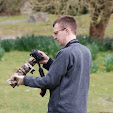I joined the ranks of the unemployed this week for the first time in 27 years. In case you were worried there, don't be, I wasn't fired from my job at the council in disgrace: fortunately, unlike many of my colleagues in cash-strapped local government, I was able to leave at a time of my own choosing, and I shall return to full-time employment as early as next week. But more on that later, the week between jobs provided an opportunity yesterday to get out and about with the camera.
 |
| Northern Wheatear at Maiden Castle yesterday |
 |
| The morning light was better at the Bill earlier in the day, but the Wheatears more distant |
 |
| A female was with the male on a dung-heap at Maiden Castle |
 |
| A second, less well marked bird at Portland Bill |
It being mid-March, as the first summer migrant birds had been trickling in all week, there was one species in particular on my mind: Wheatear. Rising early I negotiated the road works onto Portland and hit the Bill slopes just as they were being kissed by the rising sun. The immediate reward was two male Wheatears. Seeing these long distance migrants from Africa catching the morning light was a tonic and appeared as proof that spring was winning the battle with winter, despite the forecast for weekend snow. Skylarks singing overhead seemed to prove the point. An obliging male Stonechat on the slopes and a Black Redstart in the Bill quarries completed an attractive trio of chats for the morning.
 |
| Female Black Redstart |
 |
| A presumed migrant in the Bill quarries |
 |
| Male Stonechat - often obliging around the Pulpit Inn |
 |
| Skylark at Portland Bill |
A brisk southerly saw rough seas crashing around the obelisk at the Bill's southern tip, so much so that the Purple Sandpipers which are often directly below had been pushed up to almost eye level, providing unusually good photo-opportunities. They were rather more successful at dodging the spray than I. I headed up to the more sheltered Church Ope Cove to dry off and look for Wall Lizards - more on them in a later post - and was treated to my first photographable butterfly of the year: a Peacock which basked briefly on a warm rock.
 |
| Purple Sandpiper |
 |
| Purple Sandpiper |
 |
| The Bill was taking a bit of a pounding on Friday |
 |
| Peacock at Church Ope Cove |
On the subject of butterflies, the return to gainful employment mentioned above starts very shortly in the form of probably my dream job at
Butterfly Conservation, the UK charity dedicated to saving butterflies and moths, which is based here in Dorset. If you're not a member already, you
obviously should be: they do great work for our hard-pressed
Lepidoptera. And now there is the extra incentive that by joining you will be keeping me too busy to clutter up the internet with so-so photos :-). Speaking of which, here are a few more chats to end with - and why not!



















































